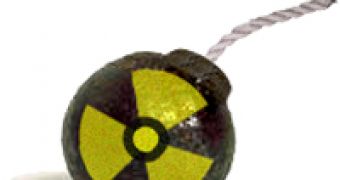A dirty bomb is a simple explosive device used not so much to produce extensive damage but to contaminate a designated spot with radioactive materials. It is often associated with nuclear bombs, although it doesn't have anything in common with them aside from being an explosive device that uses small amounts of nuclear material. The primary role of a dirty bomb is to spread fear (it is characterized as being a terrorist weapon), since the radiation damage produced on living tissue in the outcome of the explosion is rather small.
The explosion power of a typical dirty bomb closely matches that of conventional explosives such as TNT, since the radioactive material is packed around an ordinary explosive material. When a dirty bomb explodes, the hot expanding gases resulted from the blast rapidly propel into space carrying along with them a cloud of radioactive material that spreads over a relatively wide area. The contaminated area can expand severely if the wind is blowing.
Radiation damage
Radiation damages living tissue through a process called ionizing radiation, which occurs when alpha particles, beta particles, gamma rays and X-rays penetrate the body. When this happens, the atoms in the tissue enter an excitation state and eject one or more electrons, becoming positively charged. The electrons escaping from one atom then collide with other ones to create even more ions.
This in turn triggers uncontrolled chemical reactions inside the cells of the body, which either destroys the DNA or causes it to mutate. The death of numerous cells inside the tissues leaves room for the onset of various diseases, such as cancer, which is corroborated with the mutation of other cells, thus triggering radiation sickness.
Nuclear material
Dirty bombs use as nuclear material naturally occurring radioactive isotopes with relatively short half-lives, meaning that they decay with the passing of time. The content of protons, neutrons and electrons in the respective radioactive isotope makes it unstable and changes continually, until temporary stability is lost and it splits into other more stable isotopes. Atom decay releases a lot of energy, inflicting massive damage through ionizing radiation.
The human body is subjected daily to some amounts of ionizing radiation coming from the Sun and the surrounding natural environment. It too can produce some types of cancer, although the risk is extremely low as compared to other radiation sources.
Of course, the damage produced by any bomb is usually directly related to the amounts of explosive material used to build it. Calculating the damage produced by a typical dirty bomb proves somehow more difficult considering that radiation poisoning is involved, albeit in this case estimates are just as good.
A bomb containing roughly 4.5 to 23 kilograms of TNT and a small amount of cesium-137 for example, would probably produce more deaths as a result of the TNT explosion rather than that of radiation poisoning. A quick thorough shower after the incident should ensure a risk exposure between minimum and moderate. The people closer to the blast site would probably feel some of the effects of radiation sickness, while others will have slightly elevated chances of developing some type of cancer later in life.
Additionally, the blast site would become uninhabitable until decontamination is carried out.

 14 DAY TRIAL //
14 DAY TRIAL //